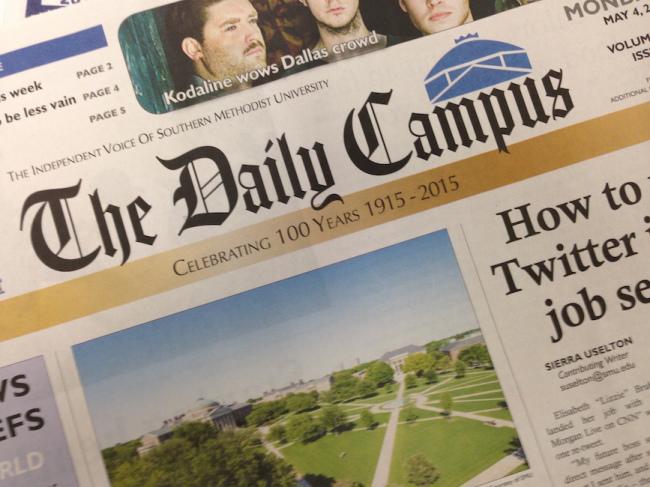The Daily Campus, the independent voice of Southern Methodist University since 1915, will be celebrating its 100th year in print this fall. In conjunction with its centennial celebration, The Daily Campus is announcing changes to its publication format and frequency.
Beginning with its summer “AARO issue,” The Daily Campus will adjust its print edition from its current broadsheet format to a tabloid format, making the print edition look more like The Dallas Observer. During the fall semester, the paper will transition from a three-times-per-week publication to a weekly publication, printing and distributing the newspaper every Thursday instead of on Mondays, Wednesdays and Fridays.
The transition is designed to better serve the SMU community with enhanced and more frequent online offerings and a print edition with more in-depth and longer-form stories, according to Editor-in-Chief Lauren Aguirre.
“With three issues a week, we were very event-driven,” Aguirre said. “More often than not, most of the news content would be event recaps and previews. That isn’t a bad thing, but people don’t look at print papers for event coverage anymore. For quick hit stories, you tend to look online.”
Editors hope to make the print edition more appealing with better feature stories, planning, photos and graphics to encourage readers on campus to get excited about The Daily Campus’ work. The online-first model will place these event stories, recaps and breaking news online first, so The Daily Campus website is updated more frequently throughout the day.
According to Jake Batsell, journalism professor and board member on the Student Media Company Board of Directors, stories will be more reader-focused and will dig deeper into issues, and will also bring buzz to print products as it will be catered more toward students and their lives. He believes the change will build on the momentum created throughout the year focusing on the paper’s digital product.
“There is going to be even more energy and enthusiasm behind our shared digital media operation which includes SMU-TV as well,” Batsell said. “I hope it will be a catalyst to drive even more energy toward our digital product so we are read on all student’s laptops, phones and iPads.”
The changes come in response to feedback the Student Media Company, Inc. received from its audience, advertisers and student staffers. According to Jay Miller, Student Media Company’s executive director and editorial adviser to The Daily Campus, Student Media and its Board of Directors have monitored and assessed the company’s offerings since before his arrival to SMU in July 2008.
“I would say we — like virtually ever college and commercial media operation in the country — have been seriously considering a shift of this nature for the past five years,” Miller said.
Miller said The Daily Campus’ audience is visiting the website more frequently and often than ever before and student staffers wish to provide their audience with more coverage that includes video, audio and interactivity.
“For our print edition, which we will publish now on Thursdays, we know our student staffers want to provide more in-depth pieces, while also focusing on weekend activities on The Hilltop in the areas of lifestyles and sports,” Miller said.
A directed study by senior Meredith Carey sparked the Board’s attention about the benefits of these changes. She presented her findings and work to the Board in late January.
Carey found that many colleges and student media publications, such as Texas Christian University and the University of Texas at Arlington in the Dallas-Fort Worth-area among many others nationwide, had made the transition to a once-weekly print edition without negatively impacting advertising sales.
Miller and the Board continued to weigh the benefits and potential drawbacks of such a transition, but it was the student staffers’ desire to shift to a digital-first mindset and create a new, enhanced print product that made the final decision a unanimous one.
Kent Chapline, instructor and director of Student Media at TCU, saw positive changes in the content and advertising sales of The Skiff, TCU’s student-run paper, which moved from printing four times per week to one time per week in fall 2013.
In one year, from fall 2012 to fall 2013, advertising sales at The Skiff increased by 11 percent, Chapline said.
“It’s important to note that 11 percent represents a true increase in sales and does not take into account a decrease in costs of printing,” Chapline said.
Chapline believes this is because advertisers are more intrigued by the weekly model that creates a sense of urgency among advertisers to connect with TCU students.
TCU’s Student Media moved toward a digital-first approach to match the changing trend in the news industry and give its students more real world experience.
Like The Daily Campus’ upcoming plans, TCU’s The Skiff distributes its paper Thursday mornings. Chapline said they chose Thursday deliberately to find a balance between upcoming events, weekend news, midweek coverage and longer feature stories. The Skiff also uses a single-cover story model that is often published as the center spread story to give readers something new and encourage paper pick-up.
Chapline said these cover stories have led to better feature reporting, another similar goal with The Daily Campus.
The major difference between the student-run publications is that The Daily Campus, unlike The Skiff, receives no funding from its university. SMU Student Media functions independently, both financially and journalistically, from SMU.
However, members of the Student Media Board of Directors believe these changes will encourage students to look to The Daily Campus for in-depth stories and online interactivity.
“I think the SMU community — students, staff, faculty and alumni — can look forward to a continuation of the award-winning coverage that SMU Student Media has been providing on The Hilltop for the past 100 years — albeit packaged in a slightly different way,” Miller said.
Make sure to check out SMU’s newest student-run paper this summer and fall to see these changes in action.









